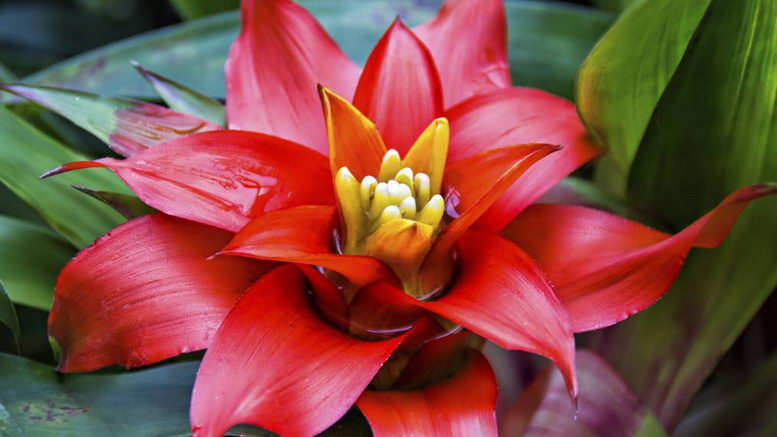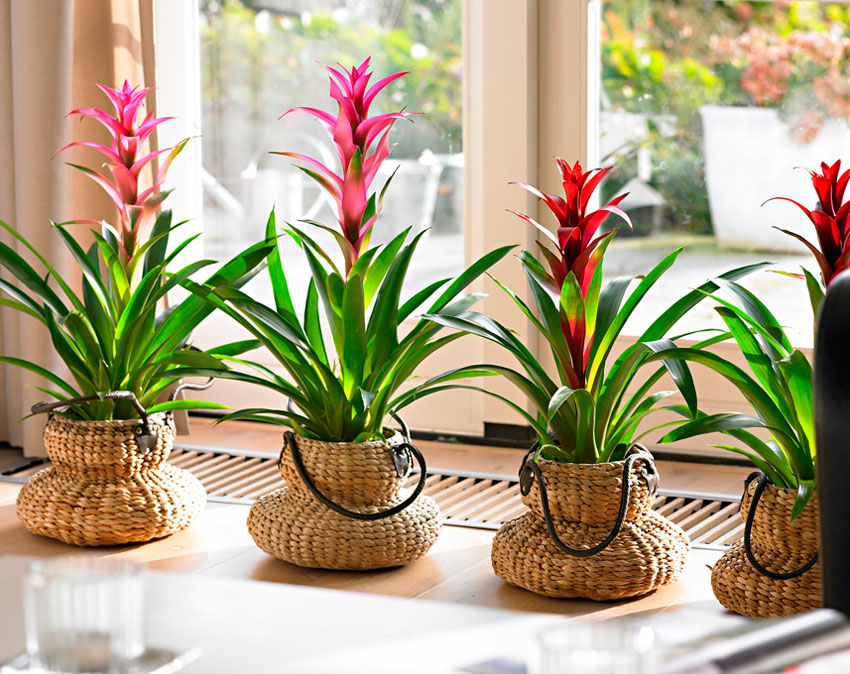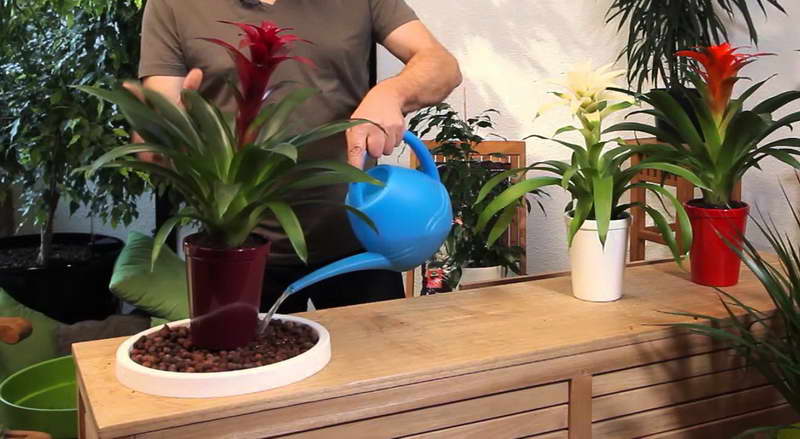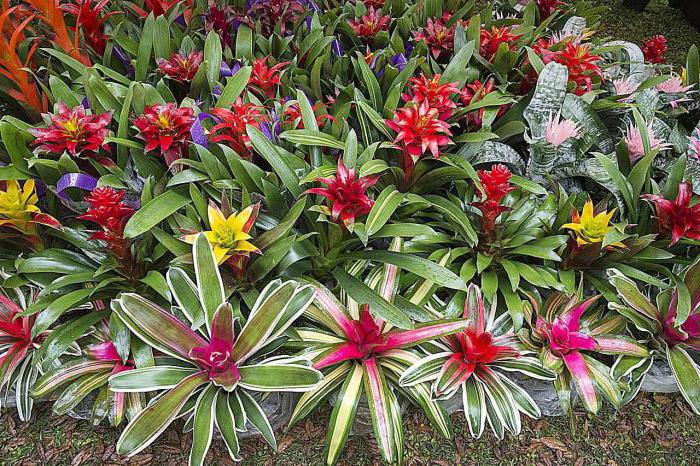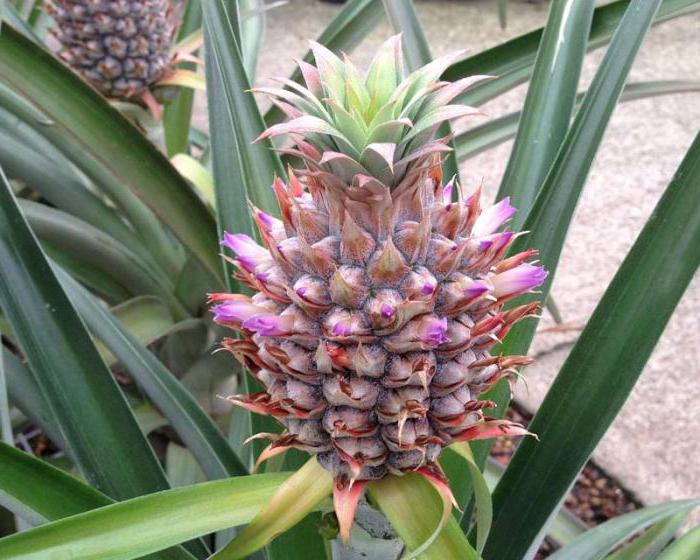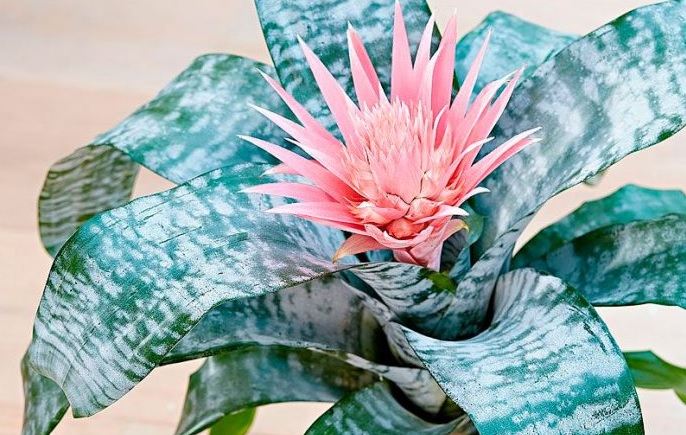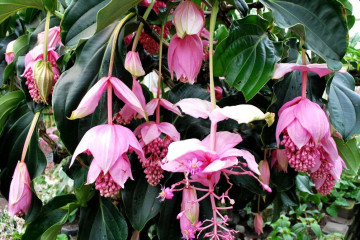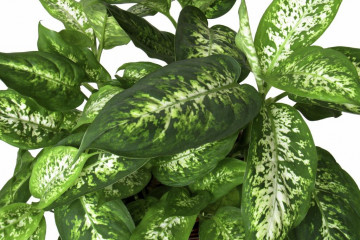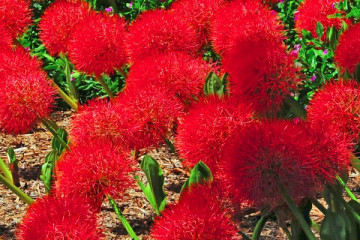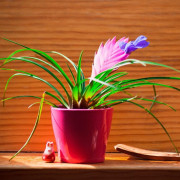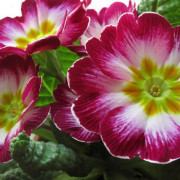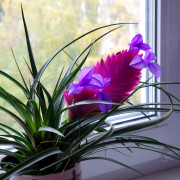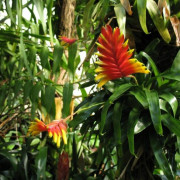Bromeliad flower - home care
Content:
Many growers are familiar with the unusually beautiful bromeliad flower. The genus unites more than 60 plant species. Many of them are very popular in home floriculture. Bromelia is native to the tropics and subtropics of Latin America. A variety of species are united under one common name - bromeliad mix.
The meaning of the name of the bromeliad flower and the description of the plant
Lovers of exotic prefer to grow bromeliad houseplants at home for their unpretentiousness to the surrounding conditions.
In most cases, the stem of the flower is shortened. The pale green dense fleshy leaves of a leathery structure form a funnel. At the top, spectacular inflorescences of bright red or deep yellow color are formed. They are spike, racemose or paniculate. Large inflorescences give the plant a very beautiful bizarre shape.
After flowering, boxes with fruits or juicy berries remain on the bushes. Splices into seedlings are characteristic of some species of the bromeliad plant. The flower has about 35 varieties.
Bromeliad flower - home care
There is no better place to grow bromeliads than a windowsill in the house, since the plant needs plenty of sunlight. It is preferable if it is absent-minded. Direct sunlight is harmful, causing foliage burns. As a result, the plant begins to wither and ache. The flower does not tolerate stagnant air, so it is necessary to provide it with regular ventilation, but protecting it from drafts.
Optimum temperature
In summer, a comfortable temperature for bromeliads is + 20 ... +25 degrees. In winter, it is enough to provide a thermal regime in the range of + 15 ... +18 degrees. Bromeliad houseplants are thermophilic. 12 degrees above zero is a critical temperature for them.
Watering and moisturizing
An important condition for keeping a flower is to ensure regular watering. You need to moisten the soil quite often. In the hot months, watering is provided almost daily. It is recommended to pour water into a funnel, which is formed by foliage. If it is difficult to do this, the liquid is poured into the potting soil. Liquid should not be allowed to stagnate on the surface of the soil mixture. But there should always be water in the pan. In winter, watering can be done with a minimum frequency, no more than once a week.
The bromeliad plant feels comfortable with an air humidity of 70%. The leaves need to be systematically looked after and moisturized. You can use a spray bottle.
Sometimes an aquarium or any container with water is placed near the bush. It is very good to have a household electric humidifier. Often pebbles are poured into the pallet and a little liquid is poured, and a pot with a flower is placed on top.
For irrigation, you need to use settled water. In this way, chlorine is disposed of. Due to the fact that the process of photosynthesis occurs in plants, you need to monitor their purity, and once every 7 days, wipe the foliage surface with a damp cloth.
The choice of soil mixture
Bromelia loves acidic soil. It is not recommended to use garden soil for the preparation of the substrate. The best option would be a ready-made store-bought mixture for growing orchids, to which sand and peat are added. When self-preparing the soil, you can include humus there, add expanded clay, charcoal or sphagnum. This composition is well drained.
Top dressing
Liquid fertilizers are used to feed the flower. Distinguish between foliar and root dressing. In the first case, a concentrated liquid intended for flowering plants is diluted with water, and the resulting composition is poured into a spray bottle and the crown is sprayed with it. In the second case, you can simply water the earth with a concentrated composition. For plants at the peak of flowering, the frequency of feeding is 2 times a month. In winter, this procedure is reduced to 1 time in 1-2 months.
When the pot is very small, the following step-by-step procedure must be followed:
- Prepare a pot and fresh soil.
- Pour the earth into a container.
- Make a hole in the ground and pour water into it.
- Move the plant to the resulting groove.
- Fill the soil on top, tamp it so that the flower is stable.
Flowering period
Bromeliad blooms in the summer months, but it is possible to bring this term closer with a little trick. If you put a vase filled with apples next to a flower, or put a pot in a bag of apples for 10 days, the process will speed up. The bottom line is this: the ethylene gas released by the fruit stimulates earlier bud formation.
What to do next if the bromeliad has faded? After waiting for complete drying, the remains of the plant are carefully cut off. The peculiarity of the genus is that flowering occurs only once. Then babies appear in the mother's outlet (new bushes are grown from them), and she herself becomes lifeless.
Under the name bromeliad mix, the following plant varieties are often sold in the store:
- Bilbergia;
- bromeliad de Zapata;
- indoor pineapple;
- Nidularium;
- Ehmeya.
Each of them has its own personality. For example, de Zapata's bromeliad is shaped like a shoe. Another species is similar to pineapple.
Descriptions of some species
One of the easiest plants in this family to grow is Bilbergia. She adapts to life even in dimly lit places. Pinkish flowers, twisting in a spiral, appear in the cold season (from November to January) to the delight of their owners.
The name of a large group of flowering plants native to Brazil comes from the Latin word "Nidus" - nest. Rigid leaves form a dense rosette. The shortened stem grows from the center and ends with an inflorescence of spikes with densely located large red flowers. The flower is very light-loving. The rules for caring for him are no different from the basic ones.
The South American echmea has an unusual peak-like bracts. The leaves form a rosette and there are thorns at the edge of the leaves.The plant blooms only once.
Reproduction
After the end of flowering, shoots appear at the base of the plant, which are carefully cut off with a sharp knife. They are called kiki. Then they need to be covered with charcoal and slightly dried. Ready-made seedlings can be planted in the ground, preferably from February to April. Light soil is moistened and kicks are placed in it.
The perennial bromeliad is characterized by a powerful root system. When nursing at home, a flower takes root in a short period of time (no more than 2 months after transplantation). During this period, you need to regularly moisten the ground and maintain the air temperature in the room at about 20 degrees Celsius. New plants will bloom in one and a half to two years.
Diseases
The main enemies of bromeliads are scale insects, spider mites or mealy worms. Once infected, the plant can be saved by manually collecting the parasites. Then the leaves are washed with soapy water. You can add a little alcohol or use a ready-made insecticide.
If the irrigation regime is violated in combination with infection with fungal diseases, the plant rots.
If minimal care is provided, and the place where the bromeliad stands is correctly chosen, the flower will delight with its original appearance for a long time.
